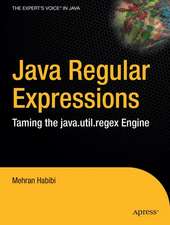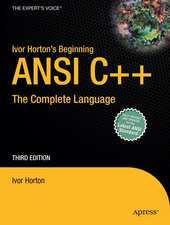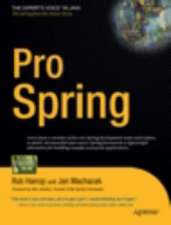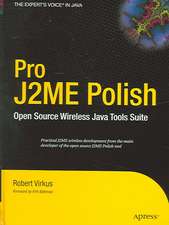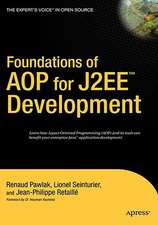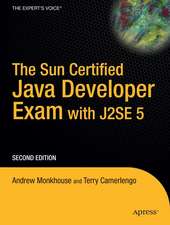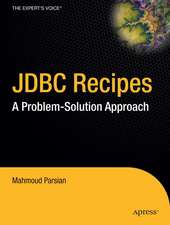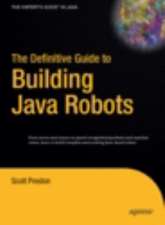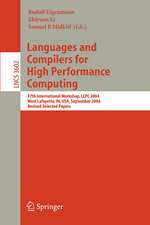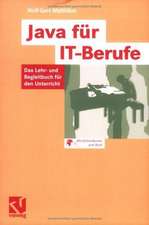Practical JSF in Java EE 8: Web Applications in Java for the Enterprise
Autor Michael Mülleren Limba Engleză Paperback – 30 mai 2018
In Practical JSF in Java EE 8, you will learn to use the JavaServer Faces web framework in Java EE 8 to easily construct a web-based user interface from a set of reusable components. Next, you add JSF event handling and then link to a database, persist data, and add security and the other bells and whistles that the Java EE 8 platform has to offer.
After reading this book you will have a good foundation in Java-based web development and will have increased your proficiency in sophisticated Java EE 8 web development using the JSF framework.
What You Will Learn
- Use the Java EE 8 and the JavaServer Faces APIs to build Java-based web applications through four practical real-world case studies
- Process user input with JSF and the expression language by building a calculator application
- Persist data using JSF templating and Java Persistence to manage an inventory of books
- Create and manage an alumni database using JSF, Ajax, web services and Java EE 8's security features.
Those new to Java EE 8 and JSF. Some prior experience with Java is recommended.
Preț: 297.91 lei
Preț vechi: 372.38 lei
-20% Nou
Puncte Express: 447
Preț estimativ în valută:
57.01€ • 59.30$ • 47.07£
57.01€ • 59.30$ • 47.07£
Carte disponibilă
Livrare economică 25 martie-08 aprilie
Livrare express 08-14 martie pentru 124.03 lei
Preluare comenzi: 021 569.72.76
Specificații
ISBN-13: 9781484230299
ISBN-10: 1484230299
Pagini: 335
Ilustrații: XXII, 480 p. 82 illus.
Dimensiuni: 178 x 254 x 32 mm
Greutate: 0.87 kg
Ediția:1st ed.
Editura: Apress
Colecția Apress
Locul publicării:Berkeley, CA, United States
ISBN-10: 1484230299
Pagini: 335
Ilustrații: XXII, 480 p. 82 illus.
Dimensiuni: 178 x 254 x 32 mm
Greutate: 0.87 kg
Ediția:1st ed.
Editura: Apress
Colecția Apress
Locul publicării:Berkeley, CA, United States
Cuprins
Part I: TinyCalculator Project.- 1. TinyCalculator.- 2. Foundations.- 3. JavaServer Faces.- 4. Expression Language.- 5. HTML Friendly Markup.- 6. Configuration files.- 7. Testing with Selenium.- 8. Recap TinyCalculator.- Part II: Books Project.- 9. Preparing for Java EE 8.- 10. Introducing the Books Application.- 11. Starting the Books App.- 12. Java Persistence API.- 13. JSF Templating.- 14. Becoming International.- 15. Bean Validation.- 16. Contexts and Dependency Injection.- 17. Conversation Scope.- 18. Links.- 19. Responsive Design.- 20. Summary and Perspective.- Part III: Intermezzo Project.- 21. Intermezzo.- 22. JSF Lifecycle revised.- 23. Repetitive Structures.- 23. JSF and BeanValidation.- Part IV: Alumni Project.- 24. Alumni.- 25. Validation.- 26. Ajax.- 27. Building Composite Components.- 28. Secure Passwords.- 29. Data Facade.- 30. Activation Mail.- 31. Cleanup (or Scheduled Tasks).- 32. Authentication and Authorization.- 33. Account Handling.- 34. Classroom Chat (WebSockets).- 35. Changing Look and Feel.- 36. Constants Handling.- Afterword.- Appendix A.- Appendix B.- Appendix C.- Appendix D.- Appendix E.
Notă biografică
Michael Müller is an IT professional with more than 30 years of experience including about 25 years in the healthcare sector. During this time, he has worked in different areas, especially project and product management, consulting, and software development. He gained international knowledge not only by targeting international markets, but also by leading external teams (from Eastern Europe and India).
Currently, he is the head of software development at the German DRG institute [http://inek.org]. In this role, he is responsible for Web applications as well as other Java and .NET projects.Web projects are preferably built with Java technologies such as JSF with the help of supporting languages like JavaScript.
Michael is a professional JSF user and a member of the JSR 344 and JSR 372 (JSF) expert groups. Due to his community activities he was invited to join the NetBeans Dream Team and became a member January 2016.
Currently, he is the head of software development at the German DRG institute [http://inek.org]. In this role, he is responsible for Web applications as well as other Java and .NET projects.Web projects are preferably built with Java technologies such as JSF with the help of supporting languages like JavaScript.
Michael is a professional JSF user and a member of the JSR 344 and JSR 372 (JSF) expert groups. Due to his community activities he was invited to join the NetBeans Dream Team and became a member January 2016.
Textul de pe ultima copertă
This is an enhanced practical, projects-driven guide to web development with the Java EE 8 and JSF (JavaServer Faces) APIs and web framework. This book combines the theoretical background with a practical approach by building 4 real world applications. By developing these JSF web applications, you'll take a tour through the other different Java EE technologies like JPA, CDI, Security, WebSockets, and more.
In this book, you will learn to use the JavaServer Faces web framework in Java EE 8 to easily construct a web-based user interface (UI) from a set of reusable components. Then, you add event handling that JSF also offers and then link to a database, persist data, add security and other "bells and whistles" that Java EE 8 platform has to offer towards building complete enough running web applications.
The goal of this book is to create a good foundation in Java-based web development and take you to a more sophisticated level and be proficient i
n Java EE 8 web development using the JSF framework. After reading this book, it can serve as an invaluable reference with four takeaway web applications that can be used as templates for your own web projects.
What you'll learn:In this book, you will learn to use the JavaServer Faces web framework in Java EE 8 to easily construct a web-based user interface (UI) from a set of reusable components. Then, you add event handling that JSF also offers and then link to a database, persist data, add security and other "bells and whistles" that Java EE 8 platform has to offer towards building complete enough running web applications.
The goal of this book is to create a good foundation in Java-based web development and take you to a more sophisticated level and be proficient i
- What is in the Java EE 8 and the JavaServer Faces APIs and how to use these to build Java-based web applications through four different and practical real world case studies
- Process user input with JSF and the expression language by building a calculator application
- How to persist data using JSF templating and Java Persistence to manage a book store inventory
- Build and manage a music library with JSF lifecycle, BeanValidation and more
- Create and manage an alumni database and mailing list using JSF, AJAX, web services and Java EE 8's security features.
This book is for those who are new to Java EE 8, JSF. This book could be for those with some prior experience with Java EE 7 and JSF but want a refresher using latest versions of Java EE and JSF APIs. Some prior experience with Java like Java SE or core JDK is recommended though.
Caracteristici
Contains four real-world projects to enhance your skills Broadens your knowledge of expression language, internationalization and localization, context and dependency Injection, and more Utilizes REST, Vaadin, and AngularJS


